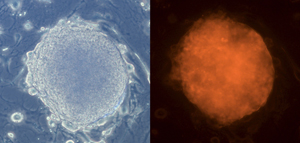New resource to unlock the role of microRNAs

A new resource to define the roles of microRNAs is announced today in Nature Biotechnology. The resource, called mirKO, gives researchers access to tools to investigate the biological role and significance for human health of these enigmatic genes.
mirKO is a ‘library’ of mutant mouse embryonic stem (ES) cells in which individual, or clustered groups of microRNA genes, have been deleted. Using these tools researchers can create cells or mice lacking specific microRNAs, study expression using fluorescent markers, or inactivate the gene in specific tissues or at specific times in development. This is the first mammalian microRNA knockout resource; the only other comprehensive resource of mutated microRNA genes is that for the nematode worm.
microRNAs – first named only ten years ago – are encoded by more than 500 genes that are predicted to regulate about one third of protein-coding genes. Consisting of short stretches of 21 to 23 nucleotides, microRNAs act by interfering with the activity of messenger RNAs. Studies over the past five years have shown that microRNAs are likely to play important roles in disease such as cancer and disorders of the heart, the immune system and auditory system.
“We have generated a resource of microRNA knockout alleles in mouse ES cells that are standardized with respect to design and genetic background that researchers can access through repositories. In many cases, microRNAs with overlapping messenger RNA target specificities occur at multiple locations throughout the genome. To address these complexities a comprehensive resource is valuable to enable the creation of compound mutants in cells or mice.”
Dr Haydn Prosser Lead author on the research from the Wellcome Trust Sanger Institute
The first step was to develop DNA vectors to target the microRNA genes: the team produced two alternative vectors that could, if desired, be used to knock out both copies of a particular microRNA in mouse ES cells.
The team inserted newly designed DNA vectors in place of the microRNA genes, successfully knocking out about 400 so far.
“The biology of microRNAs will be revealed only when we can rigorously examine their activity, their role in individual tissues, and at specific times in development. Our paper shows that the tools within mirKO can do that.
“We have tagged genes with a colour reporter, developed a mutation that can be induced when required and produced mice carrying mutations. This is an important proof of principle.”
Professor Allan Bradley Senior author on the study and Director Emeritus of the Sanger Institute
In previous research, Professor Bradley’s team showed that a specific microRNA played a role in the development of a component of the immune system: in its absence, mice develop signs similar to those of human autoimmune disease and are less resistant to infection.
The resource is built on cassettes of genetic components that can be swapped through a technology called recombinase mediated cassette exchange (RMCE). “We have designed the targeted alleles to be adaptable in order that researchers can efficiently alter particular microRNA loci in a multitude of alternative ways to provide information additional to straightforward null mutants. In this respect we have developed a research toolbox that will help researchers define the role of microRNAs in health and disease,” says Haydn Prosser.
In one configuration the wildtype microRNA locus was reconstituted while being flanked by recombinase sites in order to facilitate time- or tissue-specific expression. A second RMCE cassette contains a gene that produces a red fluorescent protein: when this is swapped into a mutated microRNA gene, it reflects the activity of the mouse microRNA gene so its activity can be studied. The team showed that this method accurately reflected the known activity of two microRNA loci.
The developing suite of tools has already been invaluable to researchers.
“This is clearly a valuable resource which will make research easier and more efficient. In our research into regulatory RNAs, we are using this resource to investigate the role of individual microRNAs during early development and how their deregulation might contribute to the etiology of cancer.”
Eric Miska A group leader at the Wellcome Trust/Cancer Research UK Gurdon Institute in Cambridge
Information and details of the mirKO resource can be accessed through the International Mouse Knockout Consortium. The biological materials are being transferred to repositories for distribution to the research community.
More information
Funding
This work was funded by the Wellcome Trust.
Publications:
Selected websites
International Knockout Mouse Consortium
The International Knockout Mouse Consortium database was developed with funding from the European Union and the US National Institutes of Health.
The Wellcome Trust/Cancer Research UK Gurdon Institute
The Wellcome Trust/Cancer Research UK Gurdon Institute is part of Cambridge University. Funding from its two main sponsors, and other sources, supports research into the complementary areas of Cancer and Developmental Biology.
The Wellcome Trust Sanger Institute
The Wellcome Trust Sanger Institute, which receives the majority of its funding from the Wellcome Trust, was founded in 1992. The Institute is responsible for the completion of the sequence of approximately one-third of the human genome as well as genomes of model organisms and more than 90 pathogen genomes. In October 2006, new funding was awarded by the Wellcome Trust to exploit the wealth of genome data now available to answer important questions about health and disease.
The Wellcome Trust
The Wellcome Trust is a global charitable foundation dedicated to achieving extraordinary improvements in human and animal health. We support the brightest minds in biomedical research and the medical humanities. Our breadth of support includes public engagement, education and the application of research to improve health. We are independent of both political and commercial interests.


